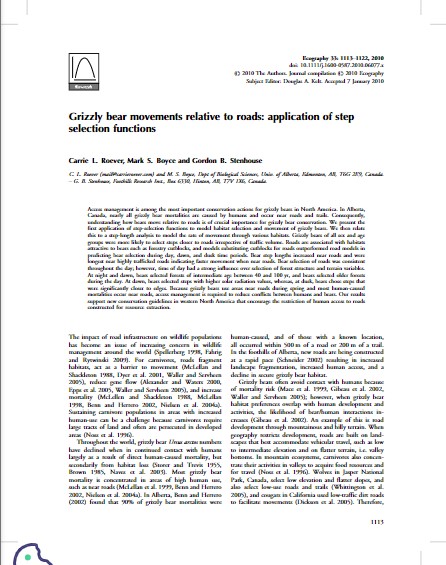Grizzly bear movements relative to roads: Application of step selection functions
Bosque Modelo:
Foothills
Temática:
Conservación
Tipo de documento:
Artículo científico
Resumen
Access management is among the most important conservation actions for grizzly bears in North America. In Alberta, Canada, nearly all grizzly bear mortalities are caused by humans and occur near roads and trails. Consequently, understanding how bears move relative to roads is of crucial importance for grizzly bear conservation. We present the first application of step-selection functions to model habitat selection and movement of grizzly bears. We then relate this to a step-length analysis to model the rate of movement through various habitats. Grizzly bears of all sex and age groups were more likely to select steps closer to roads irrespective of traffic volume. Roads are associated with habitats attractive to bears such as forestry cutblocks, and models substituting cutblocks for roads outperformed road models in predicting bear selection during day, dawn, and dusk time periods. Bear step lengths increased near roads and were longest near highly trafficked roads indicating faster movement when near roads. Bear selection of roads was consistent throughout the day; however, time of day had a strong influence over selection of forest structure and terrain variables. At night and dawn, bears selected forests of intermediate age between 40 and 100 yr, and bears selected older forests during the day. At dawn, bears selected steps with higher solar radiation values, whereas, at dusk, bears chose steps that were significantly closer to edges. Because grizzly bears use areas near roads during spring and most human-caused mortalities occur near roads, access management is required to reduce conflicts between humans and bears. Our results support new conservation guidelines in western North America that encourage the restriction of human access to roads constructed for resource extraction.
Información Bibliográfica
Autor:
Roever, C.L., Boyce, M.S., & Stenhouse, G.B.
Revista:
Ecography
Año:
2010
N°:
-
País :
Canadá
Páginas:
1113 - 1122
Volumen:
33
Idioma:
Ingles
Palabras claves
Grizzly Bear, Ursus arctos, home range, movement, habitat





